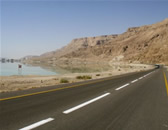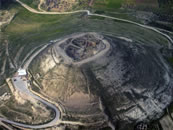
Zoomable map of this hike

I set off from the Jerusalem bus station at 10:15, arriving at Masada at noon.
As I climbed up the rocky path my shoulders were already aching from my heavy pack loaded
 down with four liters of water. My head was throbbing from the glaring mid-day sun.
down with four liters of water. My head was throbbing from the glaring mid-day sun.
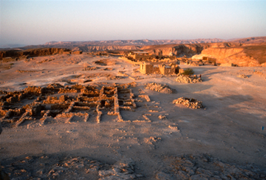 I kept trying to force down the thought that this hike through the desert in this heat by myself was crazy.
I kept trying to force down the thought that this hike through the desert in this heat by myself was crazy.
I reached the top of Har Eleazar after about forty minutes of climbing. You get a stunning view of Masada from up here.
After puzzling over the ruins on this cliff top for awhile I realized that they were the ruins of one of the Roman garrisons built to seal off Masada.
This garrison is big, and there were eight of them. The Romans put a lot of effort into their seige of Masada.
I climbed down the other side of Har Eleazar and picked up the Red Trail. By this time the sun was unbearably hot and all my enthusiasm had evaporated.
At 1:45 I knew I had to stop or get sun stroke. No more hiking in mid-day in the desert, even in April: it is just too hot.
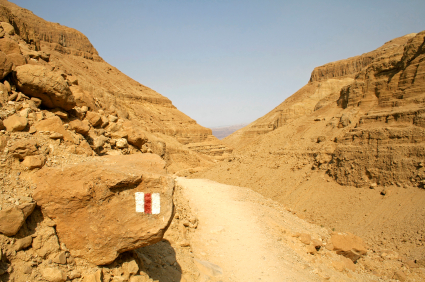 I squeezed into a desperate patch of shade and took off my pack.
I squeezed into a desperate patch of shade and took off my pack.
Actually, it is good that I have these forced siestas. It is a good time to rest, reflect, and meditate.
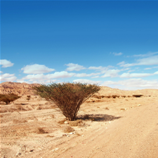
I continued at 4:00 when the sun had cooled a bit.
I walked until 6:00, when I camped in Nahal Kidud, a beautiful, restful place surrounded by light tan hills.
The western sky grew pink and the stars came out
and it felt so serene I didn’t want to disturb anything by making a fire.
I lay back and whispered thanks as millions of stars lit the sky above my sleeping bag.
David wrote in the Psalms:
בשלום יחדו, אשכבה ואישן: כי אתה יהוה לבדד; לבטח, תושיבני.
“I will lie down and sleep in peace, for you alone, O Lord, make me dwell in safety” (Ps. 4:8).
He spent many years wandering these hills and wadis, hoping not to be surprised at night by an enemy.
A prayer: Free me from fear that I may sleep securely, alone in the desert.


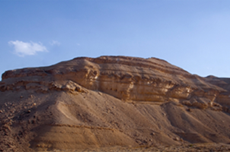
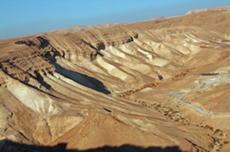


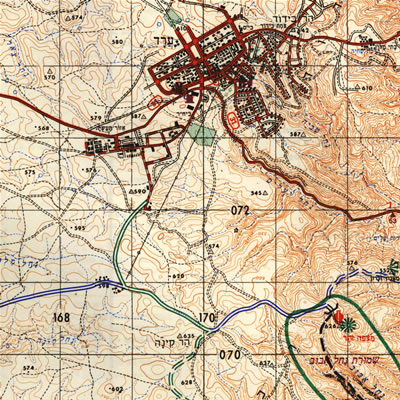
I awoke at 4:45, made tea for breakfast on my tiny camp stove, and started hiking at 6:00.
I wished I had woken up earlier; I could have been hiking by 5:00,
and I know the sun will soon be withering.
I saw my first human life a little after 7:00—a few Bedouin whom I spoke to in my broken Arabic.
I’m glad I know enough to converse a little bit.
I arrived at the road by about 7:40 and reached the center of Arad at about 8:40.
In Arad I enjoyed a rest and a cup of coffee with a number of local Arabs at an outdoor café.
I had seen an Arab sweeping the sidewalk earlier which surprised me as I had expected Arad—a planned town in the middle of the desert—to be totally Jewish.
I suppose they must be Bedouin who have come searching for opportunity in the city. I savored this hike and appreciated the life God has given us.
________________________________________________________________
I bought some food and set out a little after ten on the easternmost dirt road that leads south to Nahal Abuv.
I enjoyed the morning and the rolling green hills of Arad. I lost the trail, following too close to the highway, but after the
well-intentioned but useless advice of a Bedouin sheep herder and some hunting around, I managed to find it again.
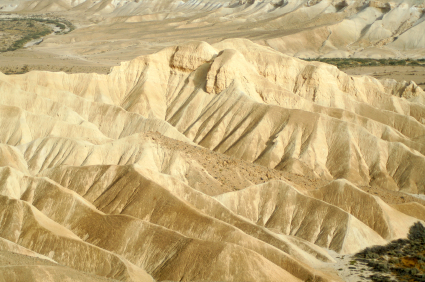
It turns out that these roads were built to serve a number of small oil wells in the hills.
I arrived at Mitzpeh Zohar a little before noon. The view was beautiful, with the Negev mountains spreading out below like circus tents.
Tan-white sand meeting the blue of the Dead Sea, with the Jordanian mountains looming up behind and joining a deep blue sky.
I climbed down through the Nahal Abuv, which is really a series of waterfalls—tough climbing and not particularly pretty.
Because of the hard climb I was surprised to come upon an old Bedouin man with his daughter and sheep.
There was a little water here, so he brought the sheep to drink; but how he got them down here I have no idea.
I left the Nahal a little before one o’clock and was greeted by a young guy with a white cloth over his head,
like a woman lighting candles.
 He had pulled his tractor off to the side of the road and came to ask for some water.
His name was Muhammad Aburabbi. He spoke Hebrew well, and even pronounced ח (khet) with an Israeli accent.
He is Bedouin and related to the Knesset member I had read about in Gavon’s book—the one with the private telephone. He was impressed that I was hiking
and sleeping alone—he said that Bedouins would be afraid to do that. We agreed that God watches over us.
He had pulled his tractor off to the side of the road and came to ask for some water.
His name was Muhammad Aburabbi. He spoke Hebrew well, and even pronounced ח (khet) with an Israeli accent.
He is Bedouin and related to the Knesset member I had read about in Gavon’s book—the one with the private telephone. He was impressed that I was hiking
and sleeping alone—he said that Bedouins would be afraid to do that. We agreed that God watches over us.
MosheDayan mentions this Knesset member in Breakthrough, p. 314: “Bedouin named Hamad Abu-Rabia, sheikh of the Abu-Rabia tribe in the Negev, south of Beer Sheva.” Muhammad mentioned to me that the sheikh had been murdered by some Druze and now another relative sat in his Knesset seat.
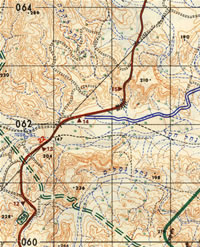
I started walking south on the deserted highway – 258 – and was making such good progress that I thought I would not have to stop for a siesta.
At 2:00 I realized I was wrong and was forced to find shade even though I was at the “16 km” sign, just 2 km from the entrance to Nahal Hemar.
I found a stand of tall, straight trees not far off the road, and slumped down in the narrow strip of shade.
But it was a refreshing rest, relaxing, eating and reading the Psalms.
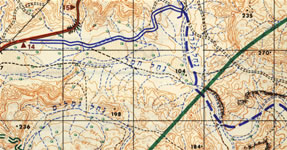 At 4:00 I continued and decided to camp right before the entrance to Nahal Hemar in an out of the way spot.
Since I stopped so early—5:30—there was enough light to read. I meditated on Luke 9 and Psalm 8.
I prayed a bit, ate dinner, and settled down to watch the stars for a long while before drifting off to sleep. In Israel, you can see the Milky Way.
At 4:00 I continued and decided to camp right before the entrance to Nahal Hemar in an out of the way spot.
Since I stopped so early—5:30—there was enough light to read. I meditated on Luke 9 and Psalm 8.
I prayed a bit, ate dinner, and settled down to watch the stars for a long while before drifting off to sleep. In Israel, you can see the Milky Way.
Reflection: I feel God's presence. The evenings are no longer a time of fear. I love to gaze at the moon and the stars in the heavens, what the psalmist calls "the work of God's fingers."



 I set off the next morning a little before six. The early morning light was shining brightly on the white rock of Nahal Hemar and casting deep shadows.
The Nahal is awesome, its huge rock cliffs surrounding me. And yet the Grand Canyon back home, which I have never seen, must be much bigger.
I set off the next morning a little before six. The early morning light was shining brightly on the white rock of Nahal Hemar and casting deep shadows.
The Nahal is awesome, its huge rock cliffs surrounding me. And yet the Grand Canyon back home, which I have never seen, must be much bigger.
I was happy to reach the spring –עין אשד (Ein Eshed) – at 7:45 since I had run out of water.
I had expected something like the spring at Eilat so I was disappointed. I had to dig a hole to find water. But I let the mud settle out and then filled my canteens and washed up.
At 8:45 I continued only now the walking became much more difficult for there was no trail, only the rocky river bed.
At 10:00 I hit the Green Trail and started hiking up.
At the top I stopped for a stunning view. The deep blue Dead Sea with Har Sdom in front and the mountains of Lebanon towering behind. The green of Neveh Zohar.
 I could also clearly see the hills of the Negev in the south. They are different from Midbar Yehuda (Judean Desert): the Negev hills look like
a huge table top laced with a maze of deep chasms. Those of Midbar Yehuda look like a huge tan tablecloth that has been snapped up in a thousand places to make small buttes.
I could also clearly see the hills of the Negev in the south. They are different from Midbar Yehuda (Judean Desert): the Negev hills look like
a huge table top laced with a maze of deep chasms. Those of Midbar Yehuda look like a huge tan tablecloth that has been snapped up in a thousand places to make small buttes.
I crossed the road at 11:00 and descended into the fantastic gorge where Matsad Arad is found. I reached it at 11:20.
My pamphlet says this was part of the “Limes” network probably built by Diocletian to protect an only road that ran through the Nahal.
How did those ancient Roman soldiers feel, stationed here in the middle of nowhere, at the bottom of this tremendous and strange Nahal,
living on a tiny tower of rock? The only point of interest within countless miles is the Dead Sea—and that, too, is unearthly and eerie.
It was here that I decided Neve Zohar would be the end of my hike. My sunburned shoulders hurt, my toes were painfully chafed, and I was really tired.
I had walked three fantastic days and this seemed like the right time to stop.
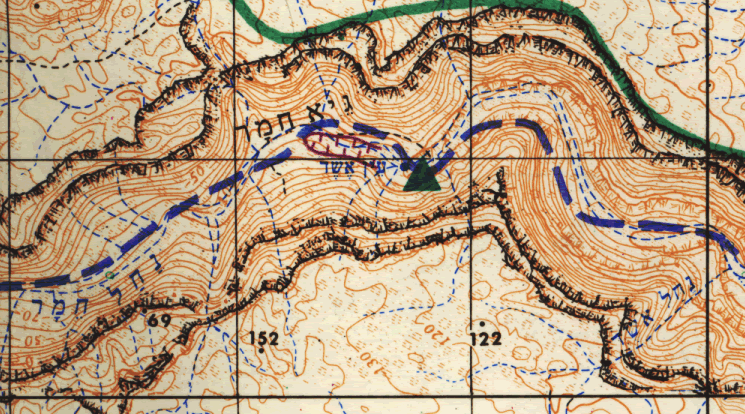
I reached the Neve Zohar bus stop after half an hour of walking at 1:20. I was dismayed to find that because it was Shabbat there was no transportation,
so I had a beer and then started walking again. I hiked up to the hotel section
– חמי זוהר (khamey zohar) – where I washed my hair in the elegant Moriah Hotel.
There are a lot of hotels here in the southern Dead
Sea, with more going up. I am surprised there is such a market.
It is beautiful, but I wouldn’t want to vacation here.

I started hitchhiking from here and was picked up immediately by three young guys from Dimona in a cool car with sheepskin seat covers.
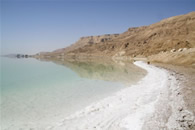 The Dead Sea was stunning.
What I had thought to be ripples or waves way above turned out to be thousands of tiny islands of salt.
They reminded me of the planets in The Little Prince, each island just large enough for a one-person kingdom.
The Dead Sea was stunning.
What I had thought to be ripples or waves way above turned out to be thousands of tiny islands of salt.
They reminded me of the planets in The Little Prince, each island just large enough for a one-person kingdom.
They gave me a beer and cranked up their American rock music.
It bothered me at first, as I tried to soak in the beauty around me.
But then I realized how appropriate it all was.
The Dead Sea is truly Israel, rugged and unique; and these three guys from
Dimona blaring American rock music are truly Israel as well.
They took me as far as Ein Gedi, and after searching in vain for a shady place I decided to try hitching back to Jerusalem.
By now I really wanted to return home; the thought of spending the night at Ein Gedi did not appeal to me.
I decided that at three I would stop hitching and find a shady place. With no success I stopped at 3:00 and started walking back towards Ein Gedi. The minute I reached the bus stop an army truck pulled up and a khayellet (female soldier) climbed in; I heard “Jerusalem.”
The other hikers who had been waiting there were going to get in but, no, they could only take one more. I shouted,
"לירושלים?" and jumped on board as they started to move away.
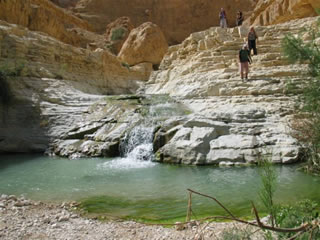
Reflection: This all happened so fast that I didn’t at first take in what a blessing it was. I thought I would have to spend the night at Ein Gedi, and suddenly I was on my way home!
What a beautiful ride home! We did not return by the regular highway that runs by Jericho.
Instead we turned east onto the road just north of Mizpeh Shalem and wound up into the Judean mountains.
It was a fitting last view of the Dead Sea. At the top of the climb we bounced onto a dusty dirt road and winding up and through these hills.
It was a dream come true, since I wanted to see this country but thought I would not be able to.
We passed through two different landscapes: gently rolling hills, and the mountains like circus tents,
that now reminded me of smoothed and worn down gothic cathedrals with their rivuleted buttresses.
The rolling hills seemed so strange and precarious, because although they were round and green, they would suddenly drop off at the edges into deep chasms.
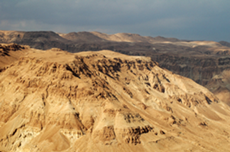 The road turned south across Nahal Tekoa, went around El-Muterideh, and finally picked up the paved road again, going south-east, after we were all well-dusted.
The road turned north-east and I finally saw the first inhabitants of this area: a small Bedouin encampment. The we came upon an army base, with a couple of burned-out tanks,
then some more Bedouin and another army base. It seemed like a pretty destitute place to be stationed, and I wondered what the soldiers did for fun.
It was a bit incongruous, the mountains of Judea with this army base and Bedouin camp sitting side-by-side.
The road turned south across Nahal Tekoa, went around El-Muterideh, and finally picked up the paved road again, going south-east, after we were all well-dusted.
The road turned north-east and I finally saw the first inhabitants of this area: a small Bedouin encampment. The we came upon an army base, with a couple of burned-out tanks,
then some more Bedouin and another army base. It seemed like a pretty destitute place to be stationed, and I wondered what the soldiers did for fun.
It was a bit incongruous, the mountains of Judea with this army base and Bedouin camp sitting side-by-side.
Suddenly a barbed wire fence flashed by, and on the inside I saw a man in black with his wife and children—like some bizarre family portrait. On a sign was written:
אין כניסה בשבתות ובחגים
(No entry on Sabbaths and Holy Days). And a road sign that said, “Ma’ale Amos.”
At last, my first view of a Gush settlement! True to what I had heard,
it appeared to be only a mass of pre-fab houses huddled together with a barbed wire fence. No fields being worked. Just a stubborn castle, as Gavon had said.
It was about 4:20 when we passed by.
We soon came upon some beautiful brown fields with some type of orchard, well-worked. This was Arab Teqoa. I was excited to visit Amos’ old haunts and when
I looked at the stone boundary fences I could imagine that the village looked about the same in his day. This was beautiful country, with green stony hills rising above,
citrus trees and vineyards growing along the roadside. It was interesting to compare the Arab village with Ma’ale Amos. Although some houses looked rather poor,
many looked nice, and they certainly blended better with the landscape than the houses of Ma’ale Amos.
We took a wrong turn, going south on 356 instead of north, but eventually we turned around and passed by Herodion—an astonishing castle.
It looks like a mountain, but they tell me there are all sorts of rooms built inside it.
We drove through Bethlehem, passed the checkpoint where Arab cars are checked before entering Jerusalem, and then on into the city.
Now I learned that this ride was even more of a gift than I had thought: they were going on the Haifa.
And when we got to Haifa, I was blessed again: they wanted to know if Ahuza was convenient for me!
